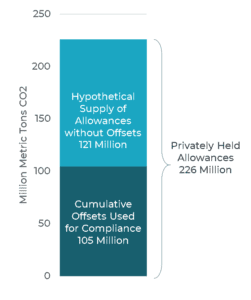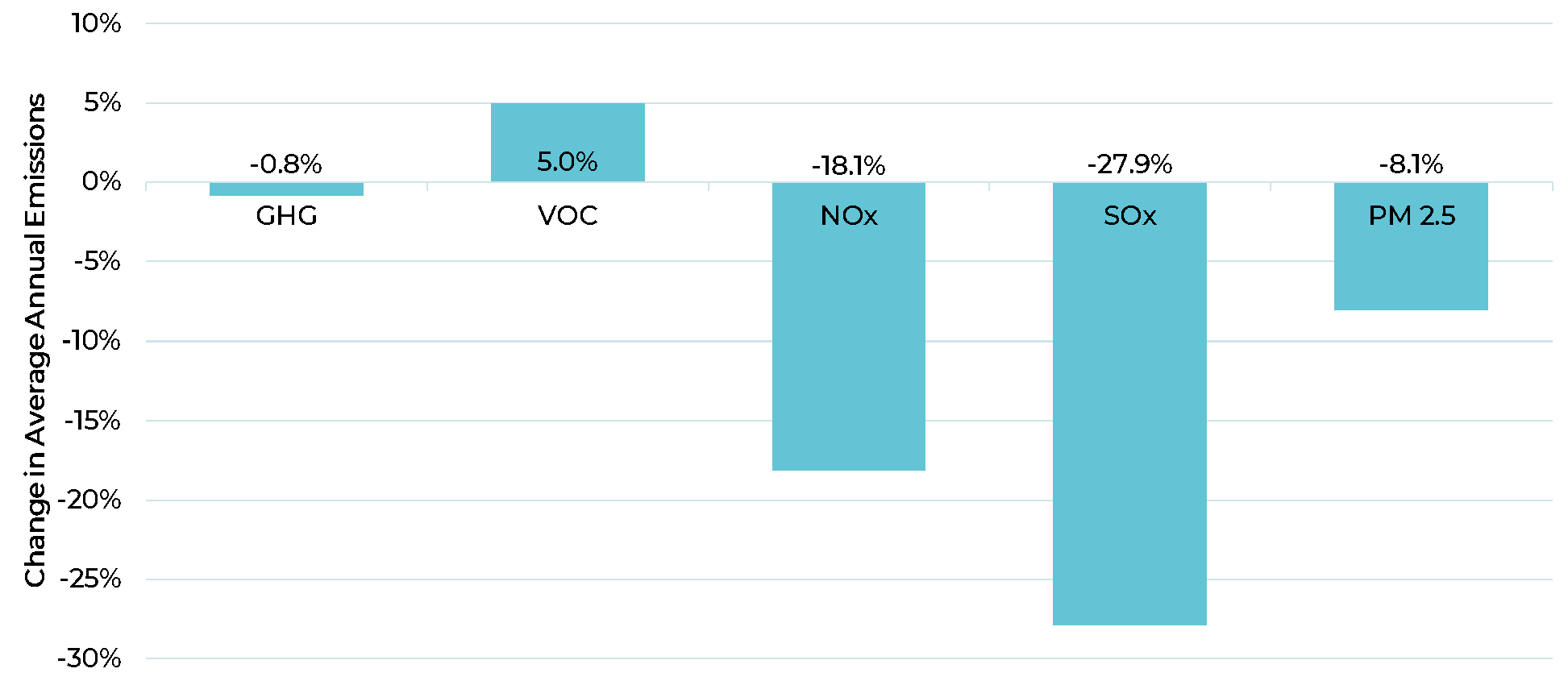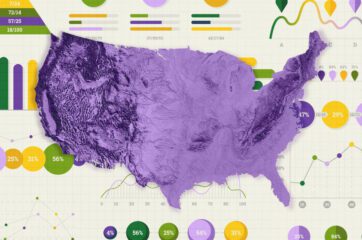A Policy Framework and Case Study of California Cap-and-Trade.
Carbon pricing is a promising policy option to help facilitate the transition to a green sustainable economy. It also has the potential to provide substantial and crucial revenue to fund the diverse solutions needed for a rapid transition.
Executive Summary
Carbon pricing is a promising policy option to help facilitate the transition to a green sustainable economy. Putting a price on greenhouse gas (GHG) emissions allows us to accurately reflect the true cost of pollution, leading the market – meaning the countless choices made every day by people and businesses – to favor cleaner ways of living and doing business.
It also has the potential to provide substantial and crucial revenue to fund the diverse solutions needed for a rapid transition. Increasing existing carbon prices and expanding to new jurisdictions can rapidly unlock trillions of dollars of private and public capital to mobilize a sustainable transition across the globe.
Meanwhile, the concept of a just transition has emerged from environmental justice (EJ) and labor roots – the change away from an extractive economy to a regenerative economy must also address deep issues of social and environmental injustice associated with the current polluter-industrial structure of the economy.
If carbon pricing is to be a central component of climate policy moving forward, it must not only reduce GHG emissions, but also embrace deep overlapping connections with linked social and environmental justice issues. This report offers a carbon pricing policy framework that contextualizes the potential role it can play in a larger green just transition.
We use California’s cap-and-trade program as a case study for this framework. Due to the state’s ambitious climate policies, large administrative capacity, and robust environmental justice community, the experience in California serves as a key learning resource for other states to extract best practices and ongoing challenges in building a just policy framework..
We highlight some key design choices for future systems to include:
Invest in community-driven, transformative projects: Investing carbon pricing revenue into community-driven, transformative projects can provide some of the most durable and effective benefits to the communities that need it most, empowering them to facilitate a just transition in the local context.
Return revenue to ensure economic protection: Providing a full scope of economic opportunity entails returning a portion of revenue directly to ratepayers, which guarantees short-term protection from increased energy costs due to carbon pricing.
Stronger carbon prices as a priority design choice: We identify higher carbon prices as a critical design choice for a just transition for three key reasons – to reduce emissions to the degree needed; to generate sufficient funds for investment; and to produce positive health outcomes in disadvantaged communities.
Complementary policies: Even with higher carbon prices, revenue return mechanisms, and inclusive investment processes, carbon pricing alone will not provide a full scope of economic opportunity and environmental justice. Future states should therefore think strategically about the intersection of carbon pricing and complementary policies, rather than design carbon pricing as a standalone policy measure.
Establishing a Framework
Components of Carbon Pricing
We can break carbon pricing down into its central design components, each of which has strengths and limitations in providing various aspects of a just transition. These components are:
1. The carbon price signal, which increases the relative cost of GHG-intensive activities, incentivizing individuals and businesses to switch to cleaner alternatives.
2. Investment of the revenue, typically into projects that further reduce GHG emissions and/or address other vital state/community needs.
3. Revenue return mechanisms, such as a household rebate or reduction in other taxes, that offsets the burden that carbon pricing can impose on vulnerable households and businesses.
4. Complementary policies, which can fulfill goals that carbon pricing fails to address. Key to this framework is that carbon pricing is contextualized as part of a larger, cohesive policy roadmap.
Economic Opportunity and Environmental Justice
Next, we consider two broad categories of benefits that each component of carbon pricing can provide towards a just transition– economic opportunity and environmental justice.
Carbon pricing can deliver economic opportunity to priority populations by providing:
- Community-level investment to create concentrated, durable benefits such as job creation, mobility, and increased access to public and private resources.
- Short-term protections to vulnerable households and small businesses, such that the policy creates a net reduction in the cost of living and/or doing business in these communities.
- Transitional assistance for fossil-fuel dependent workers and communities, such that new sources of revenue are created for families and local governments currently depending on pollution-intensive industries.
Carbon pricing can deliver environmental justice to priority populations by providing:
- Political inclusion and community-owned resources that empower local organizations and governments to facilitate the green just transition in their local context.
- Positive public health outcomes, particularly reductions in local air pollutants that disproportionately harm low-income communities, communities of color, and non-English speaking communities.
- Resilience and adaptation to climate change, as priority populations are also more susceptible to the impacts of the climate crisis on everyday life.
These non-exhaustive definitions must be decided in each state to capture the unique challenges of the local context.
Figure ES-1: A Just Carbon Pricing Policy Framework
Priority Populations
Mirroring California’s terminology, this report focuses on priority populations, which broadly constitute the worst victims of social and environmental injustice. Each state needs to have its own transparent and inclusive process to define priority populations in a comprehensive manner. California considers two subsets of priority populations:
- Disadvantaged communities are defined at the census tract level using open data on 22 different measures of pollution exposure, environmental effects, health sensitivities, and socioeconomic factors.
- Low-income populations are defined either at the census tract or household level, as those below 80% of the state median household income, although a household can alternatively qualify under area-adjusted income limits.
Whether or not California’s current policies are sufficient to achieve a just transition to a green economy remains to be seen in the coming years. Disadvantaged communities are still subject to greater levels of local pollutants in the air they breathe, both from vehicles and facilities.(1,2),Massive challenges remain in solving the transportation, housing, and public health crises across the state. Yet, the evolution of California’s climate policy over the past decade presents a vital case study opportunity to accelerate climate policy development in future states.
Invest in Community-Driven, Transformative Projects
Investing carbon pricing revenue into community-driven, transformative projects can provide some of the most durable and effective benefits to priority populations, but it requires data-driven, transparent, inclusive processes for deciding how the revenue is spent. We highlight the following actionable steps that states can take to effectively invest carbon pricing revenue to the benefit of priority populations:
- Define priority populations using data-driven, collaborative tools and an extensive public process to ensure these definitions are comprehensive, fair, and transparent.
- Legislatively mandate that a significant portion of investments from carbon pricing funds are located in, and provide real benefits to, priority populations.
- Develop open methodologies to quantify GHG reductions, local pollutant reductions, job creation, and other co-benefits in order to reveal and objectively evaluate which investments are most effective and impactful.
- Establish community-oriented governance structures and transparent review processes to provide multiple pathways for community ownership, such as advisory committees, local air districts, and place-based initiatives. This includes a strong component of education, public engagement, and technical assistance to ensure fair access to all investment opportunities.
Figure ES-2: Cumulative Outcomes of California Climate Investments (3)
 To date, California has raised nearly $12 billion for California Climate Investments (CCIs). Legislation introduced in 2012, and subsequently strengthened in 2016, requires a percentage of funds to benefit priority populations. These mandates have been repeatedly and vastly exceeded, suggesting that future systems can set more ambitious equity requirements for their climate investments.
To date, California has raised nearly $12 billion for California Climate Investments (CCIs). Legislation introduced in 2012, and subsequently strengthened in 2016, requires a percentage of funds to benefit priority populations. These mandates have been repeatedly and vastly exceeded, suggesting that future systems can set more ambitious equity requirements for their climate investments.
The benefits of deploying investments transparently and effectively far outweigh the administrative costs, with 3.5% of total investment funds being used for administration and support.(4)
States following California’s lead will have to consider the balance between long-term, large infrastructural transformations, and the need to empower localities to realize their own solutions. In California, 60% of auction revenue is continuously appropriated to large, state-planned initiatives such as rail projects and affordable housing. The remaining 40% is appropriated annually by the legislature to a wide variety of small and medium-scale projects. (5)
ES-3: Implemented California Climate Investments
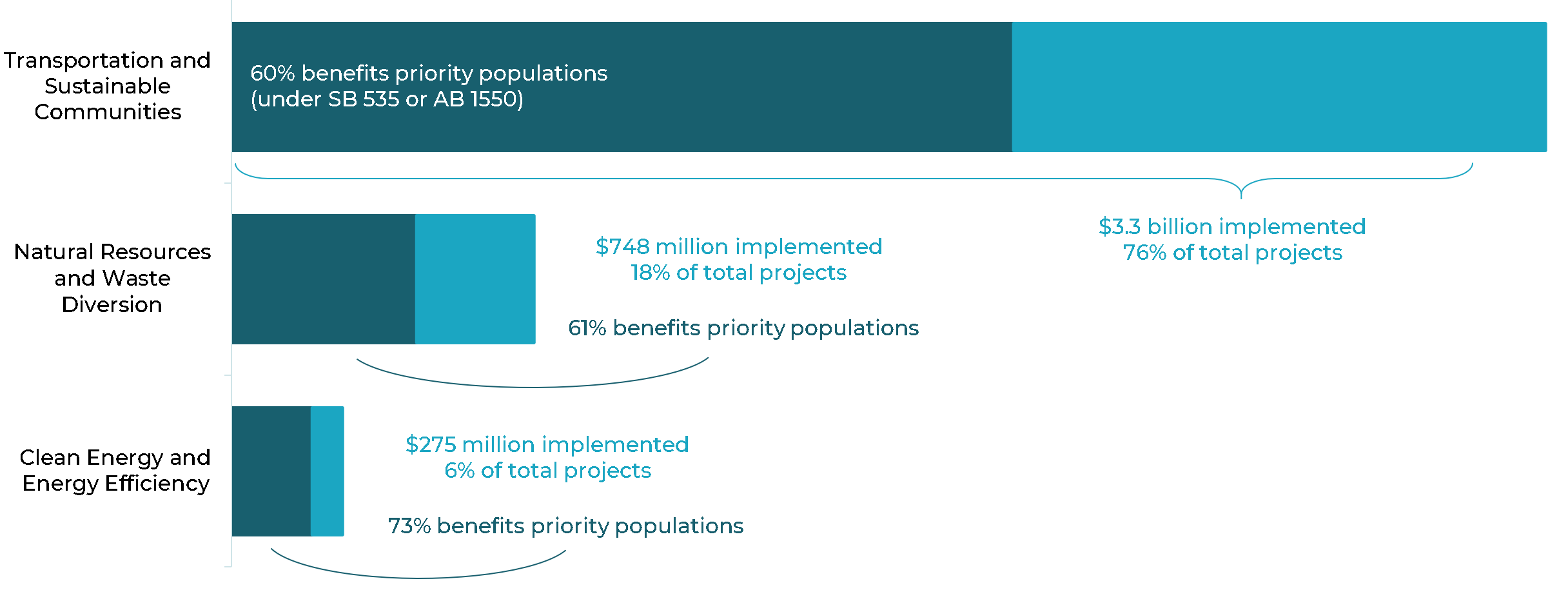
California has signaled a priority shift in the coming years towards community-level projects that provide economic, environmental, and public health benefits.(6) The Transformative Climate Communities Program is exemplary for achieving these goals by providing dense place-based funding to local actors seeking to realize their own vision for what their community could look like.
However, the program constitutes only 2% of California’s overall appropriations to date.(7) These projects with extensive co-benefits need to be expanded to align the state with just transition principles..
Return Revenue to Ensure Economic Protection
Providing a full scope of economic opportunity entails returning a portion of revenue directly to priority populations, which guarantees short-term protection from increased energy costs due to carbon pricing. The program can in fact be flipped to create progressive outcomes by leaving low-income households with a net financial gain from the program.
California’s cap-and-trade program distributes a flat climate dividend on all utility bills, resulting in average net savings of $50 to $65 on annual utility costs for low-income households.(8) This provides a base level of guaranteed economic protection without even considering the benefits from investment. However, no such protections exist for transportation fuel costs.
Low-income households, by state standards, tend to constitute a small portion of overall emissions in the typical state.(9) As such, a fairly small portion of carbon pricing revenue can provide sufficient protections to low-income households. In California’s case, an even smaller portion of the total allowance budget could be used to provide the same scale of protection to low-income households if the climate dividend was weighed according to income rather than administered on a flat basis to all households.
Stronger Carbon Prices as a Priority Design Choice
We identify higher carbon prices as the critical design choice in a just transition framework, for three key reasons:
Figure ES-4: Global Literature on Carbon Prices

Higher carbon prices are needed to accurately reflect the social cost of pollution and spur real GHG reductions
The social cost of carbon, which is an estimate of the long-term global damages caused by pollution, has been estimated to be as low as $52/tCO2e,(10) and upwards of $417/tCO2e.(11) Until these costs are reflected in the carbon price signal, our economy will continue to pollute without fully accounting for the external damages, leading to further global injustice and economic inefficiency.
The Stern-Stiglitz Commission on Carbon Pricing finds that, assuming complementary policies are in place, a carbon price of $40–$80/tCO2e by 2020 will be needed across the globe to keep temperature rise below 2°C. In contrast, California’s carbon price has grown from about $10 to $17.50/tCO2e since the launch of the program.
The degree to which higher carbon prices will be required in California remains to be seen, as the state relies extensively on additional regulations to achieve most of the emissions reductions needed.
Figure ES-5: Carbon Price and Investment Revenue in California and RGGI
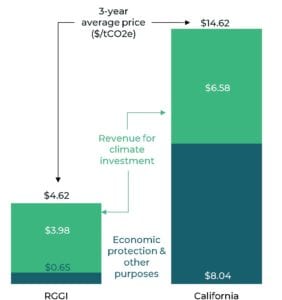
Higher carbon prices are needed to raise revenue for a green just transition
Higher carbon prices will be needed to fund the vast transformations required for a just transition to a green economy. Counterintuitively, returning a portion of revenue to households can actually raise more money for investment, if it in turn leads to higher carbon prices.
For instance, the Regional Greenhouse Gas Initiative (RGGI), a regional cap-and-trade program for electricity sector emissions in the Northeast and Mid-Atlantic, dedicates almost all auction proceeds to GHG reductions, but has maintained very low carbon prices.
On the other hand, due to higher carbon prices, California is raising significantly more revenue for climate investment per allowance sold, despite about half of the allowance budget being directed to other purposes.
Higher carbon prices increase the chance of producing positive health outcomes
The carbon price signal itself is not typically designed to guarantee reductions at the local level, but if passing a carbon pricing policy preempts or strips away other regulations that address more locally targeted emissions reductions, then it needs to fill this role to the best of its ability.
Preliminary analysis of California suggests that local pollutant emissions from stationary sources are decreasing across the state, although further research is needed to examine mobile sources of local pollutants, as well as the public health outcomes occurring specifically in disadvantaged communities.
Challenges with Cap-and-Trade and Carbon Price Signals
Cap-and-trade is not designed to prescribe a specific carbon price, and thus the degree to which the program reaches the price levels needed for a green just transition depends on the symphony of policy choices and external factors that influence the allowance market. We identify two key steps to maintaining effective price levels in future cap-and-trade programs:
Avoid permit oversupply. Cap-and-trade systems have historically provided far more allowances than required. The resulting oversupply keeps allowances cheap at auction and threatens the program’s ability to reduce emissions in later years. Future systems need to set a stricter cap, and build in periodic cap adjustments, to ensure the program maintains an appropriate level of stringency.
This includes accounting for offsets in market design. In California, we calculate that 226 million excess allowances from 2013-2018 are currently held in private accounts, which is nearly equal to the 236 million tCO2e that the program is expected to reduce between 2021 and 2030. If one allowance was removed from the market for every offset previously used for compliance, California’s current oversupply problem would be nearly cut in half.
Implement a high price floor. Should future systems fail to properly balance the supply of allowances, sufficient carbon prices can still be achieved by setting a lower limit for what price an allowance can sell for at auction.
Figure ES-6: Current Oversupply and Offset Usage in California, 2013-2018
Complementary Policies
Even with higher carbon prices, revenue return mechanisms, and inclusive investment processes, carbon pricing alone will not provide a full scope of GHG reductions, economic opportunity, or environmental justice. Future states should therefore think strategically about the intersection of carbon pricing and complementary policies, rather than design carbon pricing as a standalone policy measure.
In California, the cap-and-trade program is expected to contribute 38% of the GHG reductions needed to achieve their 2030 target. The rest of the reductions come from “complementary policies,” including those affecting short-lived pollutants, energy efficiency, and renewable energy.
Additional regulations will play a pivotal role in addressing local pollutants moving forward. AB 617 –– which directs additional resources, monitoring, and actionable authority for CARB and local air districts to reduce local pollutant emissions from stationary sources –– is the direct result of the political concern for tackling equitable air quality outcomes in disadvantaged communities.
The degree to which these policies will sufficiently address public health inequities is uncertain, but preliminary evidence suggests that some types of local pollution from stationary sources are decreasing across the state.
Figure ES-7: Change in Average Emissions from Stationary Sources, 2010-2012 to 2015-2017(12)
Conclusion
As the climate crisis continues to worsen, so does our need for bold and rapid policy solutions. Excitement around the Green New Deal demonstrates a political desire to consider not only how the climate crisis can be addressed, but also how the current polluter-industrial economy can be transformed to provide accessible transportation infrastructure, sustainable energy, good jobs, and clean air for everyone.
If carbon pricing is to play a central role in our solution to the climate crisis, it must tap into, and make progress on other key social and environmental justice issues of our time. It requires a comprehensive investment process; revenue return mechanisms to provide a fundamental level of economic protection; sufficiently high carbon prices to reflect the damages of pollution and raise the revenue needed for a green just transition; and a cohesive design strategy within a larger policy roadmap. Future states should consider this framework to maximize the economic opportunity and environmental justice that their program provides to the people that need it most.
Footnotes
1. Union of Concerned Scientists, 2019. “Inequitable Exposure to Air Pollution from Vehicles in California.”
2 . Office of Environmental Health Hazard Assessment, California Environmental Protection Agency, 2017. “Tracking and Evaluation of Benefits and Impacts of Greenhouse Gas Limits in Disadvantaged Communities: Initial Report.”
3. California Air Resources Board, 2019. “Annual Report to the Legislature on California Climate Investments Using Cap-and-Trade Auction Proceeds.”
4. Ibid.
5. Starting in FY 2020-2021, an additional 5% of auction revenue will be continuously appropriated to clean water initiatives which will increase the total ongoing appropriations to 65%.
6. California Air Resources Board, 2019. “Cap-and-Trade Auction Proceeds Third Investment Plan: Fiscal Years 2019-20 through 2021-22.”
7. California Air Resources Board, August 2019. “August 2019 CCI Data Update.”
8. Juien Gattaciecca, Colleen Callahan, and J.R. DeShazo, UCLA Luskin Center for Innovation, 2016. “Protecting the Most Vulnerable: A Financial Analysis of Cap-and-Trade’s Impact on Households in Disadvantaged Communities Across California.”
9. Marc Breslow, Climate XChange, 2019. ”Impacts of Carbon Pollution Pricing on Massachusetts Households at Different Income Levels.”
10. Interagency Working Group on Social Cost of Greenhouse Gases, 2016. “Technical Update of the Social Cost of Carbon for Regulatory Impact Analysis.” Adjusted to 2019 dollars.
11. Ricke et. al., 2018. “Country-level social cost of carbon.” Nature Climate Change.
12. Derived from California Mandatory Reporting Regulation Data, 2010-2017.



